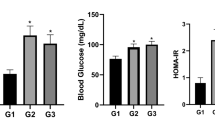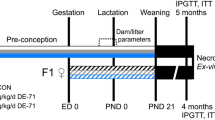Abstract
Water chlorination results in the formation of trihalomethanes (THMs) including chloroform. In human studies, fetal growth restriction has been associated with exposure to THMs during pregnancy and impaired fetal growth has been associated with an increased risk of type 2 diabetes. Therefore, the objective of this study was to determine the effect of in utero and lactational exposure to chloroform on birthweight and postnatal indicators of type 2 diabetes. Female Wistar rats were given chloroform (0 µg/L, 75 µg/L) in their drinking water for 2 wk prior to mating until parturition (in utero exposure only) or until weaning (in utero + lactational exposure). At postnatal d 1 (PND1) pups of dams exposed to chloroform had significantly higher serum glucose levels and lower insulin levels, but this effect was not due to β-cell depletion in the neonatal pancreas. Glucose homeostasis in response to a glucose challenge was not changed by chloroform treatment. Chloroform exposure did not affect birthweight; however, offspring of dams exposed to chloroform had significantly impaired postnatal growth. Although fetal and neonatal exposure to chloroform did not elicit physiological changes associated with the onset of type 2 diabetes, there were physiological changes resulting in impaired postnatal growth.
Similar content being viewed by others
References
LeBel, G. L., Benoit, F. M., and Williams, D. T. (1996). Health Canada, Environmental Health Directorate, Health Protection Branch.
Williams, D. T., LeBel, G. L., and Benoit, F. M. (1995). Health Canada, Environmental Health Directorate, Health Protection Branch.
Graves, C. G., Matanoski, G. M., and Tardiff, R. G. (2001). Regul. Toxicol. Pharmacol. 34, 103–124.
Barker, D. J., Hales, C. N., Fall, C. H., Osmond, C., Phipps, K., and Clark, P. M. (1993). Diabetologia 36, 62–67.
Barker, D. J. P. and Clark, P. M. (1997). Rev. Reprod. 2, 105–112.
Barker, D. J. P. (1998). Clin. Sci. 95, 115–128.
Godfrey, K. M. and Barker, D. J. (2000). Am. J. Clin. Nutr. 71(Suppl), 1344S-1352S.
Godfrey, K. M. and Barker, D. J. (2001). Public Health Nutr. 4, 611–624.
Seckl, J. R. (2001). Mol. Cell. Endocrinol. 185, 61–71.
Ong, K. K. and Dunger, D. B. (2002). Best Pract. Res. Clin. Endocrinol. Metab. 16, 191–207.
Chu, I., Villeneuve, D. C., Secours, V. E., Becking, G. C., and Valli, V. E. (1982). J. Environ. Sci. Health B 17, 225–240.
Longnecker, M. P. and Daniels, J. L. (2001). Environ. Health Perspect. 109(Suppl. 6), 871–876.
Bove, F. J., Fulconer, M. C., Klotz, J. B., Esmart, J., Dufficy, E. M., and Savrin, J. E. (1995). Am. J. Epidemiol. 141, 850–862.
Wright, J. M., Schwartz, J., and Dockery, D. W. (2003). Occup. Environ. Med. 60, 173–180.
Periera, M. A. (1994). Fundam. Appl. Toxicol. 23, 87–92.
Landi, S., Naccarati, A., Ross, M. K., et al. (2003). Mut. Res. 538, 41–50.
Author information
Authors and Affiliations
Corresponding author
Rights and permissions
About this article
Cite this article
Lim, G.E., Stals, S.I., Petrik, J.J. et al. The effect of in utero and lactational exposure to chloroform on postnatal growth and glucose tolerance in male wistar rats. Endocr 25, 223–228 (2004). https://doi.org/10.1385/ENDO:25:3:223
Received:
Revised:
Accepted:
Issue Date:
DOI: https://doi.org/10.1385/ENDO:25:3:223




